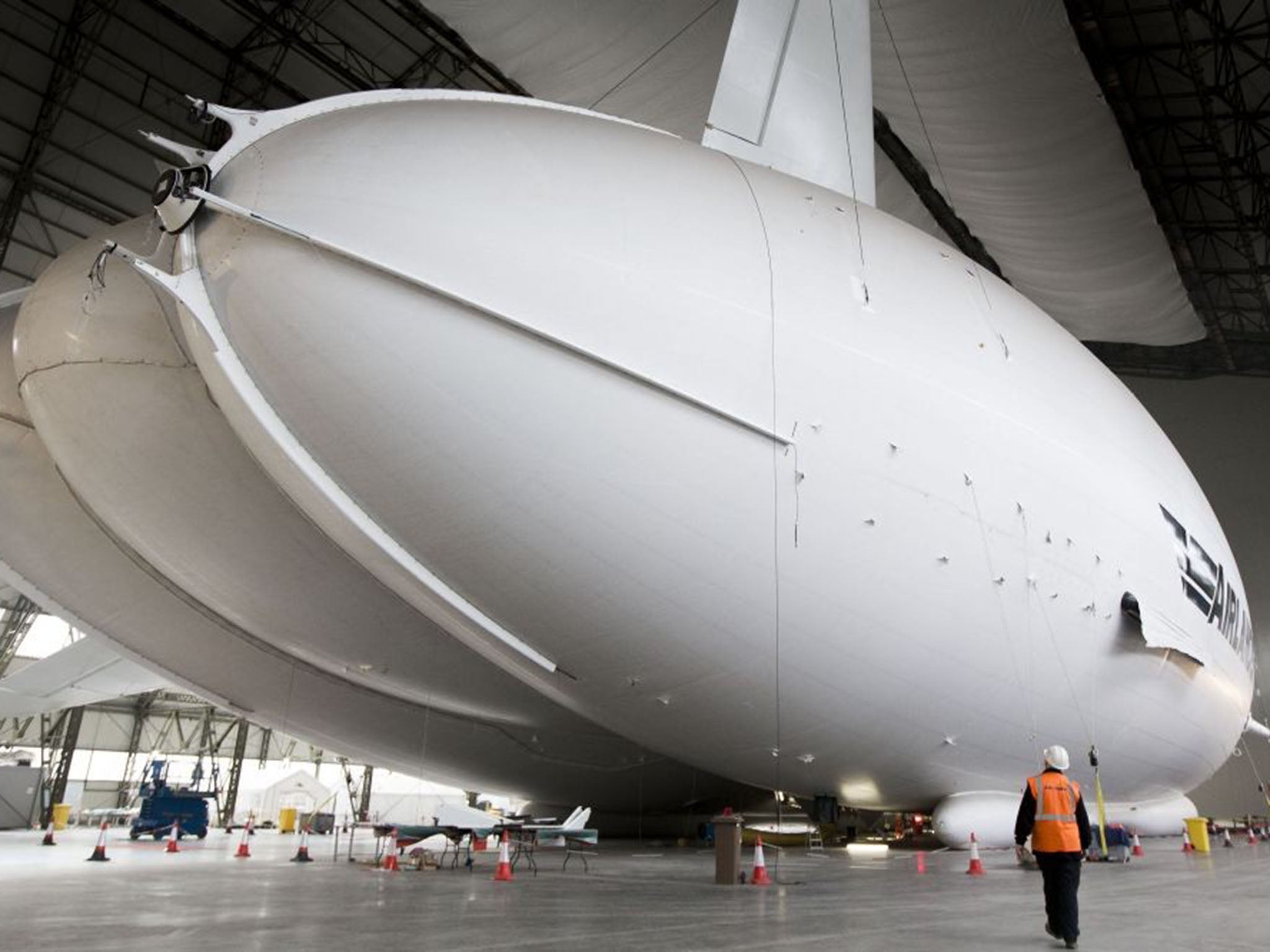Airlander 10: World's largest aircraft prepares to take to the skies
The state-of -the-art airship is 25 per cent larger than a Boeing 747 and designed to remain airborne for up to five days

The residents of Cardington in Befordshire are getting ready to watch what could be a defining moment in aviation history. In just a few weeks’ time they will see the largest aircraft in the world emerge from its vast hangar and take to the skies.
The Airlander 10 – part-plane, part-airship, and all of 90m long – is being assembled by the firm Hybrid Air Vehicles (HAV) on a site that has been associated with airships since 1915 when Shorts built the first giant hangar to build the R-31 and R-32.
The craft is nearing completion and later this month, if wind conditions permit, HAV’s chief test pilot, David Burns, will take the huge lighter-than-air craft east towards the A1M motorway. Passing drivers could witness the beginning of a revolution in air travel, cargo transport, military surveillance and even disaster relief.
The Airlander 10 prototype, which HAV hopes will be the first of 1,000 craft, is 25 per cent larger than a Boeing 747 and is designed to remain airborne for up to five days.
To the untrained eye, the giant helium-and-air-filled balloon with a 150ft-long flight deck under its belly, looks like an updated version of the craft that criss-crossed the globe in their 1930s heyday .
In fact, Chris Daniels, senior executive at HAV, says the company dislikes the term. “We actually try to get away from the name ‘airship’ as much as possible, as we think of her as much more of an aeroplane than an airship,” he says. He explains that the unique aerodynamic shape and kevlar skin means it is far stronger and generates lift, just like an aircraft wing.
Overseas Developments
Atlant: Russian firm RosAeroSystems reported to be constructing a 130m-long “red zeppelin” for the country’s military, able to carry up to 200 troops and 60 tons of cargo.
Dragon Dream: Ukrainian-born airship visionary Igor Pasternak hopes his new Aeroscraft model will be able to carry 62 tonnes of cargo later this decade.
LMH-1: US defence giant Lockheed Martin revealed the 37m-long LMH-1 at the Paris Air Show last year, claiming it would be able to carry up to 500 tons.
Airships do Brazil: Marcelo Felippes, a former officer in the Brazilian army, is developing a semi-rigid airship to overcome the huge transport challenges posed by South America’s rainforests.
This means it is not so susceptible to the high winds that can cause problems for conventional airships, and it doesn’t need a large ground crew for take-offs and landings. Nor is the shape of the envelope maintained by a metal or carbon-fibre frame, but rather by gas pressure alone.
Semantics aside, the airship largely disappeared from the skies after the Hindenburg disaster in New Jersey in 1937. But these days it is inert helium gas that is used to float these monsters of the sky, rather than highly flammable hydrogen – and many aviation experts are now saying the “second coming” of the airship has arrived, with a rush of rival projects in Europe and North America.
Part of the new-found attraction of craft like the Airlander is that they use roughly a third less fuel than a cargo jet and in the future could be fitted with vast arrays of solar panels. They are also affordable, with the Airlander coming it at around £30m compared with about £250m for a typical airliner.
The project has attracted a £3.4m investment from the British Government and the backing of Bruce Dickinson, the Iron Maiden frontman, and a trained pilot, and will eventually create 1,800 jobs.
On Sunday the second of four engines will be fitted to the aircraft as it nears completion and Mr Burns’ test flight comes closer. For the former airline pilot, the real attraction of the project isn’t the “majestic near-silent flying experience” but the craft’s “vast humanitarian potential”.
“With the ability to fly for up to five days and carry a heavy cargo the potential help in humanitarian situations is really exciting, from disaster relief after a tsunami to delivering water or even monitoring refugees at sea,” he says.
With an eye on the lucrative air freight market, HAV is exploring a future model with a 50-tonne load capacity – and this obvious potential hasn’t been missed by bigger players, including the US defence giant Lockheed Martin which is working on a rival model.
Tim Robinson, editor-in-chief of Aerospace, believes many potential customers are in “wait and see mode”. “If HAV get this right, then this could see the UK lead the world’s in a new niche aeronautical sector for air cargo, humanitarian relief, remote supply and surveillance,” he said.
Subscribe to Independent Premium to bookmark this article
Want to bookmark your favourite articles and stories to read or reference later? Start your Independent Premium subscription today.

Join our commenting forum
Join thought-provoking conversations, follow other Independent readers and see their replies